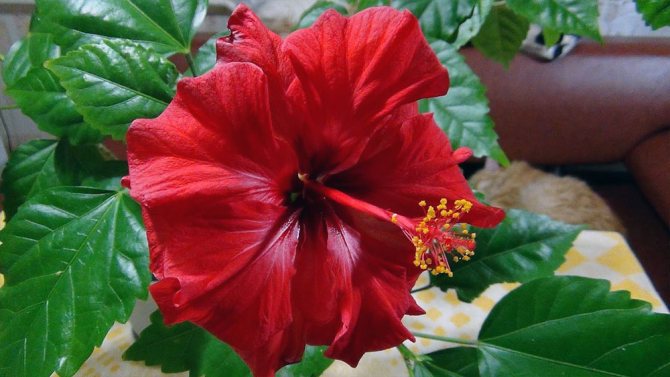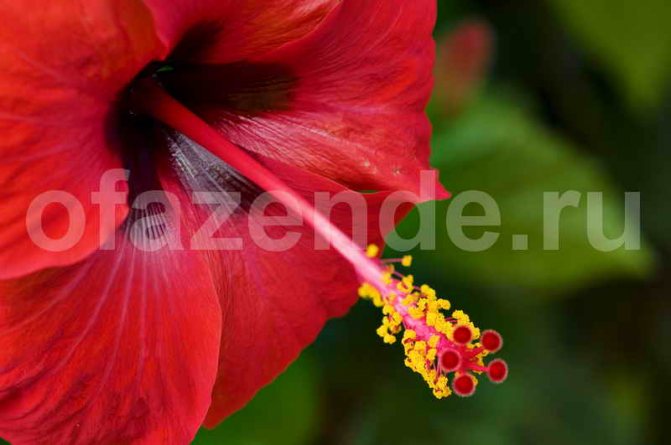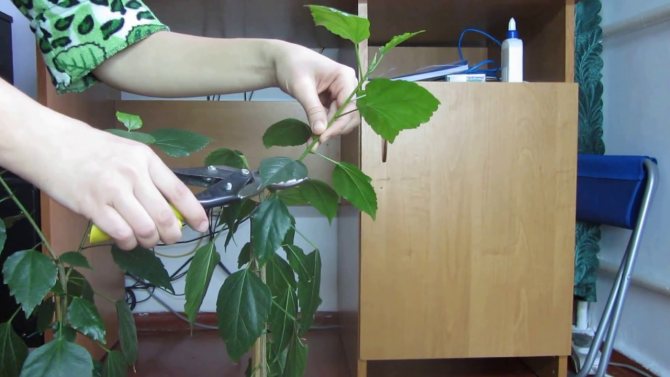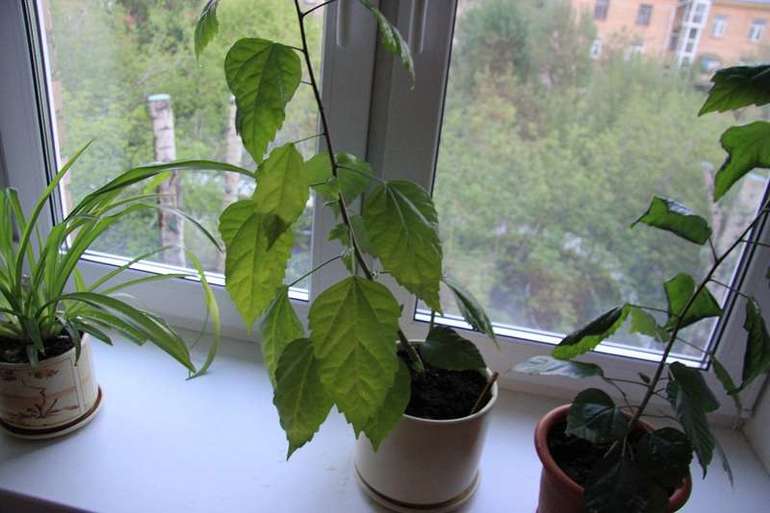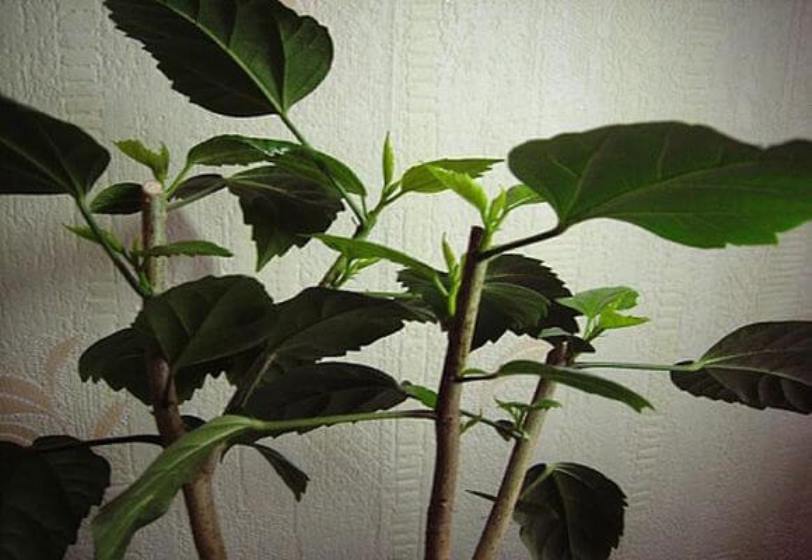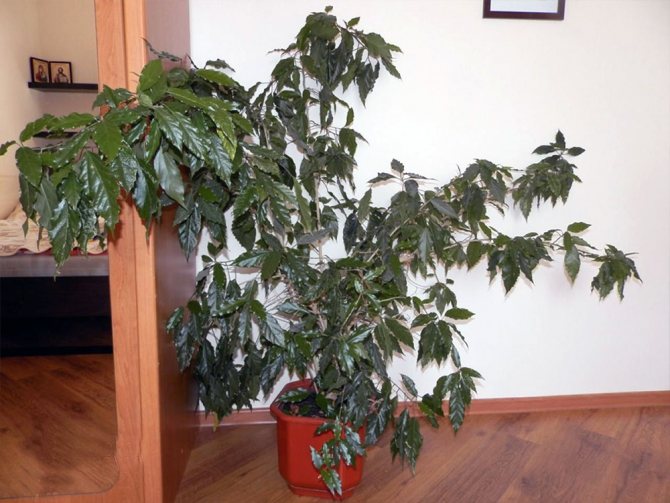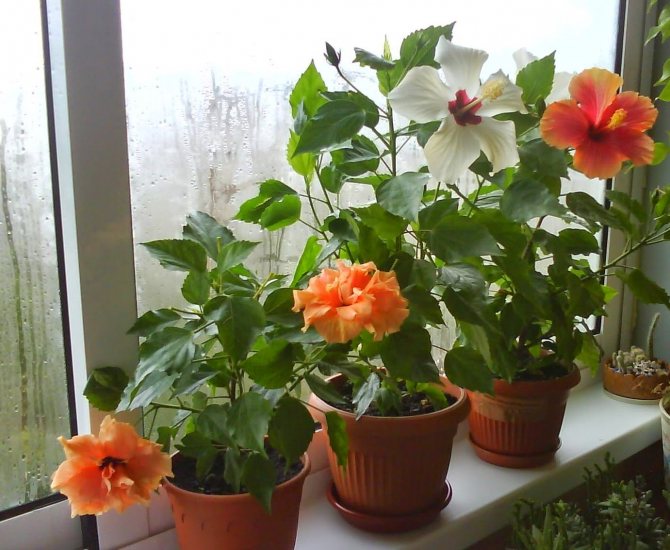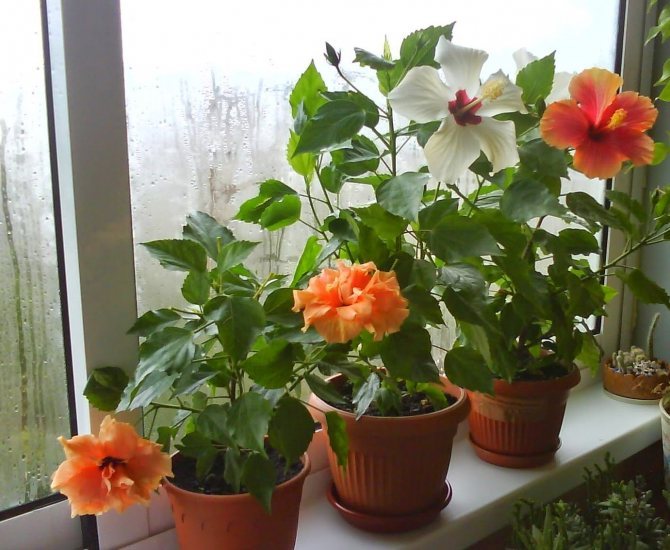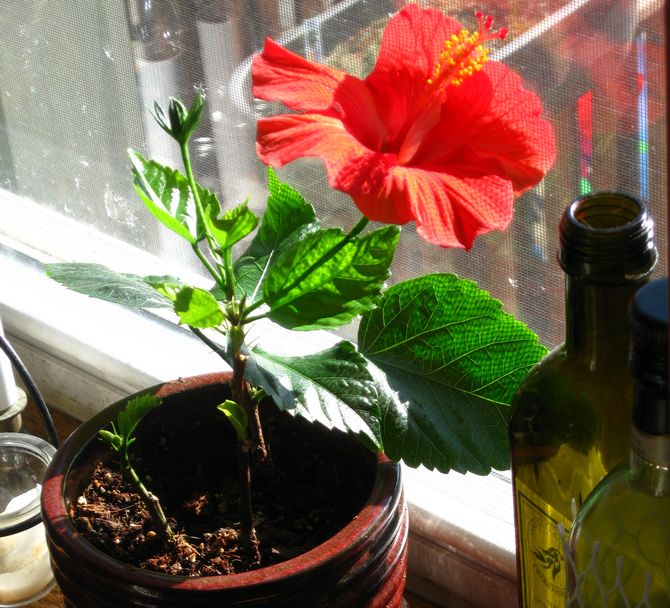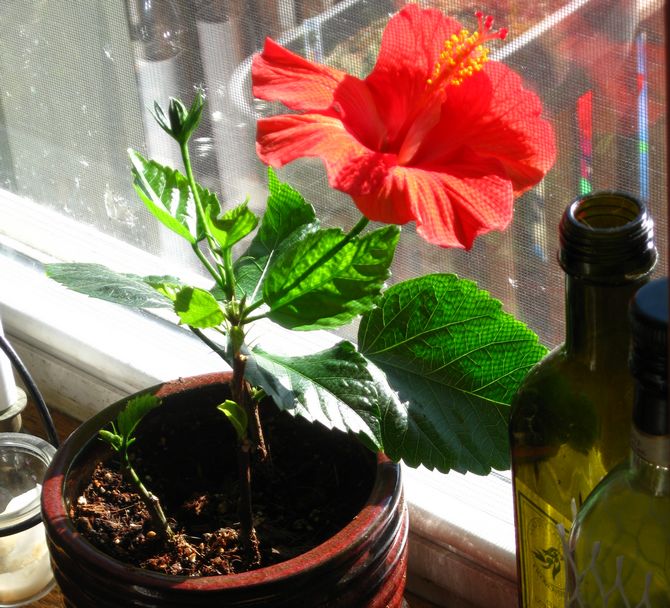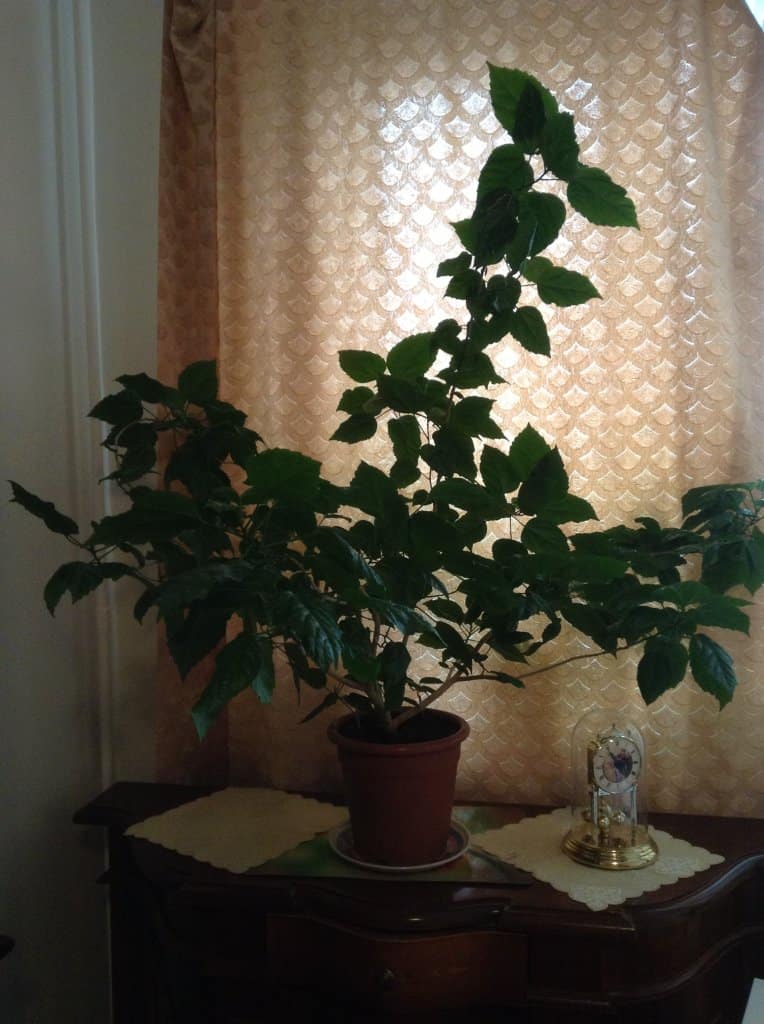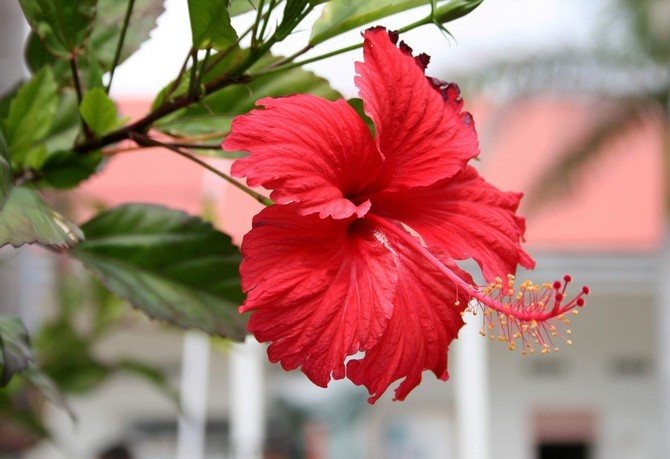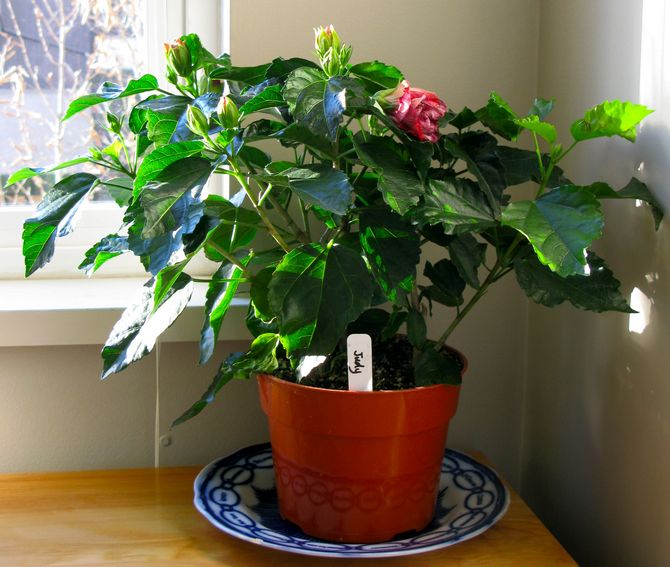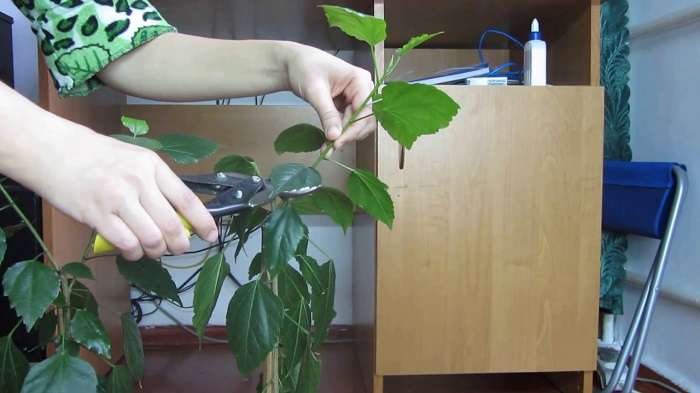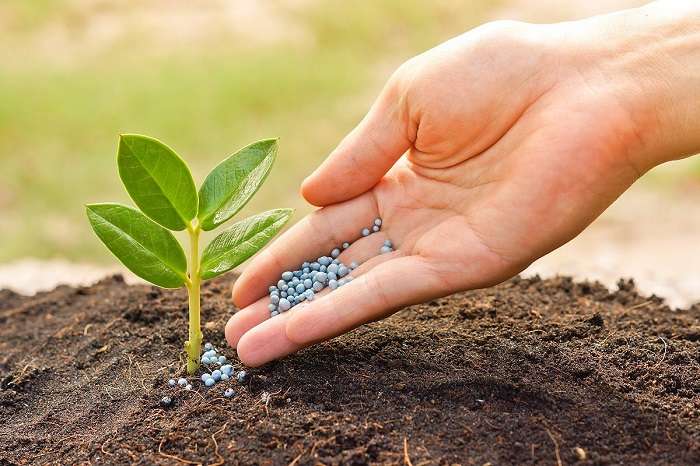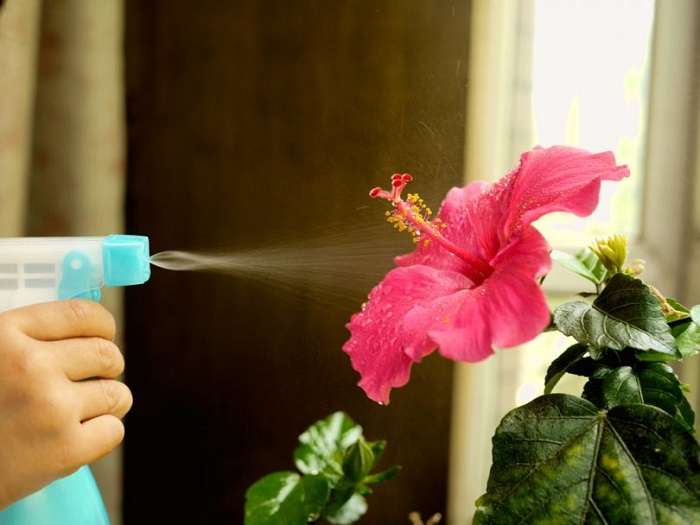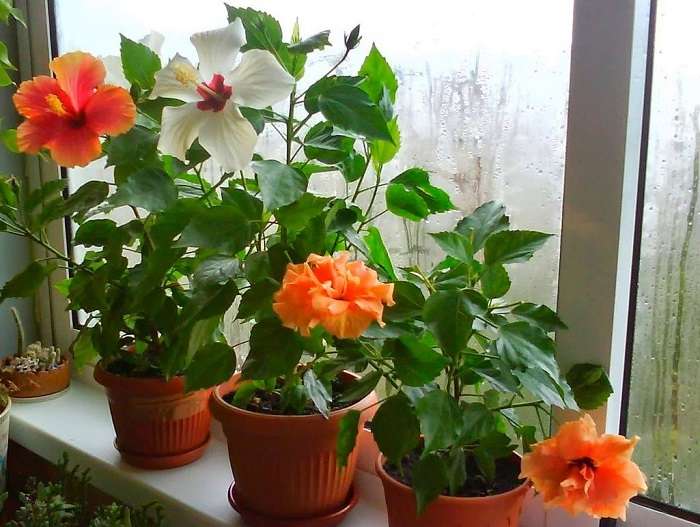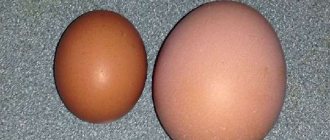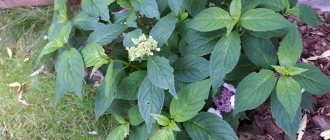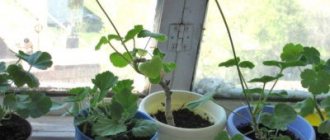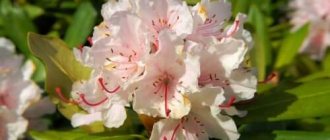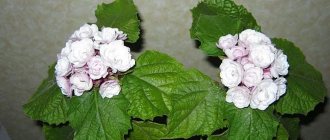How to make hibiscus bloom at home
Only by observing the recommendations of flower growers on the maintenance of a flower can you get an abundantly flowering bush every year. But if all the forces are given to flowering, then the growth of the bush will be slow.
In caring for a plant, balance and compliance with all recommendations are important:
- place of detention;
- wintering conditions;
- soil and capacity requirements;
- watering and feeding the plant;
- pruning;
- protection against diseases and pests.
Place of Containment
A prerequisite for the flowering of a Chinese rose will be its maintenance in a bright place. The sun should not burn the leaves of the flower. But in a dark room, hibiscus will not bloom.

To admire flowers in summer, hibiscus should be kept at a temperature of 12-15 degrees in winter. The room should be bright. It is at this temperature that the flowering program is laid. Do not wait for the violent opening of the buds in summer, when hibiscus blooms in winter, if kept warm.
Choosing a pot and fertile soil
The Chinese rose grows at home quickly if the plant was allocated a tub for growth and filled with fertile soil. Until the plant fills the entire clod of earth with roots, it will build up its green mass. The overgrown bush pleases with green foliage, receives proper care, but has not opened a single bud? Why does indoor hibiscus not bloom?
It is necessary to transplant the plant into a smaller container so that the roots are cramped. At the same time, they can be trimmed, removing more brown old parts. The pot should have good drainage from expanded clay or other bedding. Place the upper layer of roots almost on the soil surface. Houseplants bloom if the roots are cramped.
The composition of the soil for the Chinese rose should be fertile, but with the inclusion of clay turf. The acidity of the soil is kept closer to neutral. Charcoal chips in the soil help maintain the balance of the substrate.
Timely trimming and pinching
There is one biological feature why hibiscus does not bloom. Flowers form only on the tops of young twigs. Therefore, a home flower needs a systematic pruning or pinching. Getting the branches to bush by pruning is an important part of hibiscus care. It quickly gives young shoots, and the buds develop on them. One of the main reasons why healthy, overgrown indoor hibiscus does not bloom, is the lack of pruning.
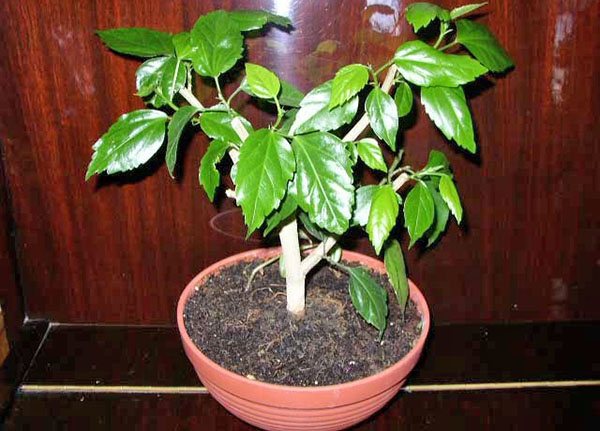

Uniform watering
It is important to water the flower properly. At any moment, all beauty can be violated precisely because of improper watering:
- The water should be soft. When using it, no scale remains in the kettle, and a film does not float on the surface of boiled water.
- For irrigation, the water must be well defended so that there are no traces of chlorine in the tap water.
- The temperature of the irrigation water should be around 30 degrees.
In summer, indoor hibiscus is watered abundantly and sprayed with leaves from a spray bottle. But between waterings, the top layer of the earth should dry out. In winter, the plant is rarely watered. In cold, damp soil, inactive roots can rot. Lack of watering or nutrition will cause the buds and flowers to shed when the hibiscus is in bloom.
Phosphate fertilizers are especially effective for flowering. It can be a superphosphate extract, or a special composition for indoor flowering plants.Fertilizers are applied only to wet soil.
What to do if hibiscus does not bloom and how to find the cause. Do not overexpose the rose tree in cold conditions. In order for it to bloom, it is necessary to exclude temperature drops during the growing season. So, if the plant is overexposed in the cold until the buds appear, and then transferred to heat, the buds will fall off from a sharp change in temperature. The same will happen if the plant gets caught in a draft.
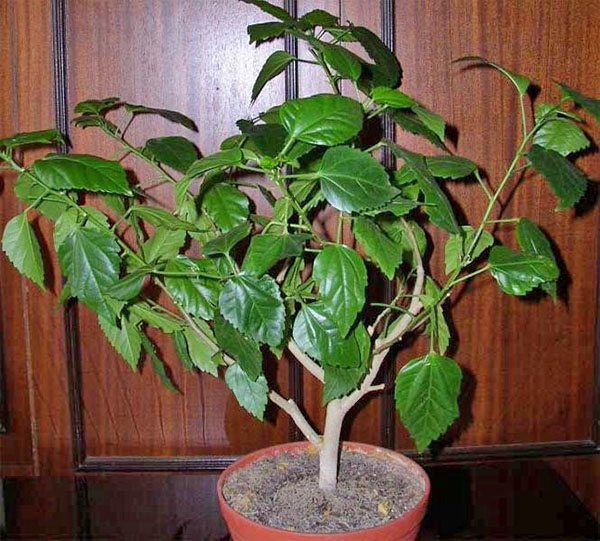

A flowering tree requires careful handling. The pot is installed in place once for the whole summer. It cannot even be rotated if the buds have already been picked. The peduncle is very fragilely attached and falls off from the slight swaying of the branch. Therefore, during flowering, you need to walk by carefully.
In summer, hibiscus loves fresh air. The flowerpots should be installed in a place protected from wind and direct sunlight. A loggia, balcony or veranda with a sun curtain will be the best place for blooming hibiscus.
Caring for an adult indoor Chinese rose tree
Cyperus - home care and reproduction
The tree-like shrub does not require difficult maintenance. It is enough to water, prune, fertilize on time, and create the necessary conditions for the winter period.
Watering mode
From February to mid-autumn, watering should be frequent, as the topsoil dries. Water should be used separated and warm. If water has accumulated in the pan, it is simply drained. During the growing season, it is important to maintain a humidity level of 70%. In hot summer, it is recommended to additionally spray the plant and water through a tray
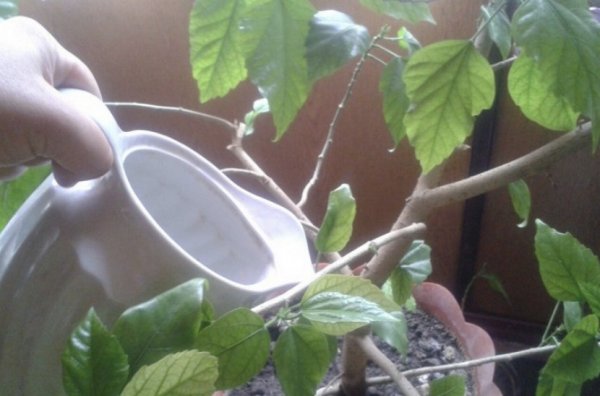

Watering
Top dressing
The growing season of the plant requires additional feeding. To feed, purchased mineral fertilizers, which are made specifically for flowering ornamental crops, are suitable. When choosing a top dressing, you should pay attention to the amount of phosphorus, it should be small. Minerals alternate with organics. From organic matter, it is preferable to use an infusion on the droppings of chickens (1:20) or cows (1:12). The frequency of feeding during the growing season is once every 2-3 weeks.
Important! It is strictly forbidden to apply top dressing to the soil with newly transplanted shrubs. Before fertilizing, be sure to water the soil so as not to burn the roots.
Features of care during flowering
The flowering period of the Chinese rose is long - three seasons in a row, excluding winter. Although there are individual specimens that can bloom during the dormant period. True, the life span of a flower is short - only 1-2 days, after which it falls off. Later, a new bud and flower of the Chinese rose is formed.
To provide the hibiscus with good lighting, it is best to place it near windows facing southeast or southwest. During the flowering period, the temperature regime should be maintained at + 18-20 degrees. In summer, indoor hibiscus can be displayed in the garden or on the balcony. But at the same time, it must be protected from wind and drafts.
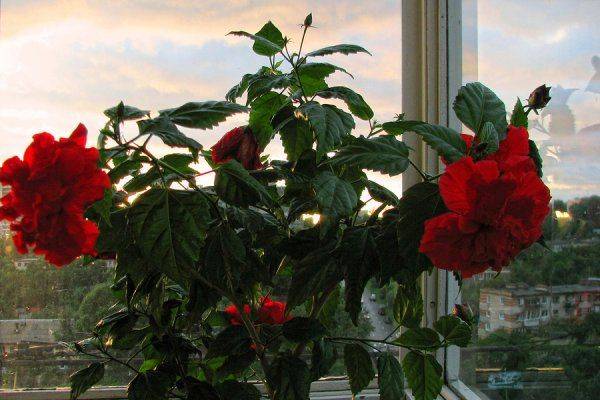

Hibiscus in bloom
Features of care during the rest period
In winter, you need to leave the plant alone so that it can gain strength for the next flowering. Watering is reduced. Top dressing is also not applied. In order not to overflow the plant, you should check the depth of the dried soil with a stick. When only a thin layer on the surface is dry, the plant is not watered.
Comfortable temperature for the winter period ranges from +15 to +18 degrees. Its value should not be allowed below +10. With this temperature regime, the rose simply will not survive. You don't need to add extra food often during the winter. It is enough to fertilize once every 30 days with potassium and phosphorus in the complex. In winter, hibiscus may not be fed at all.
Preparing for winter
Before the onset of winter, in autumn, a massive fall of foliage can occur. Those stems that are left without leaves are simply cut off.Shoots are cut, leaving only short shoots. Watering is reduced gradually so that it does not stress the plant. Nitrogen is not applied as a fertilizer so that the shoots begin to grow actively. During this period, it is worth applying fertilizer with potassium and phosphorus (once every 30 days).
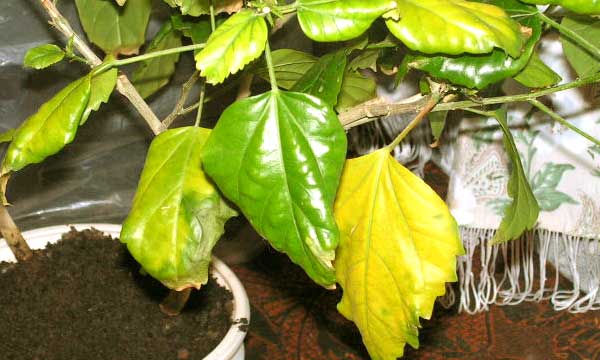

Yellowing of leaves
Why hibiscus with yellow leaves does not bloom
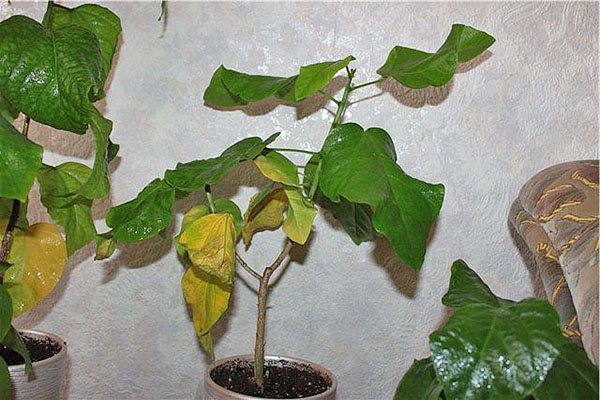

It should be noted that only healthy hibiscus flowers bloom, which have the necessary conditions for development. If spots appear on the leaves of any format or the leaf blade turns yellow, these are signs of a disease. So, green drooping leaves will say that the plant is dry, then it will lose color and buds.
Yellow leaves can give a signal that there is a disorder with the root system, and there is no need to wait for flowering under these conditions. In addition, insect pests can colonize the plant, taking food from the hibiscus. Therefore, each pruning, watering, wiping the leaves should be combined with a preventive inspection of the plant.
Compliance with agricultural technology will allow you to annually enjoy the triumphant flowering of a tropical plant, which brings harmony to the house in the relationship between family members.
Hibiscus care experience - video
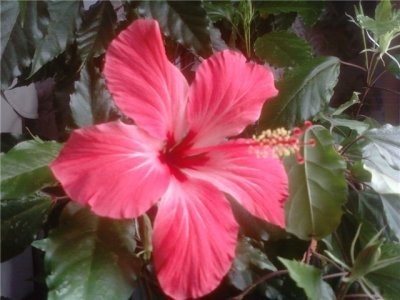

Hibiscus - a beautiful evergreen plant that is loved by many gardeners. It is held in high esteem by the peoples of the Pacific islands. And in the East, there is even a belief that this indoor flower is able to protect the house from negativity and help in achieving success.
Bloom
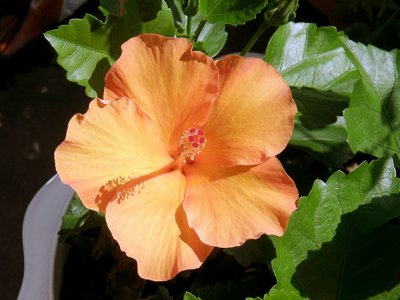

Syrian hibiscus (as it is called in science) - a representative of the Malvov family. Within Russia, it is better known as chinese rose, or rosana... Hibiscus lovers love it for its large and bright flowers of amazing beauty. However, the plant often refuses to please its owners with a scattering of buds, even if the care for this handsome man is carried out at the proper level.
Flowering chinese rose
Flowering is abundant, from March to October, the flowering of each individual flower is short-term, no more than 48 hours, then the luxurious flowers fade, they are replaced by new ones. The plant is classified as low-allergenic: the aroma has a subtle smell, the pollen of the flowers of the Chinese rose does not spread through the air.
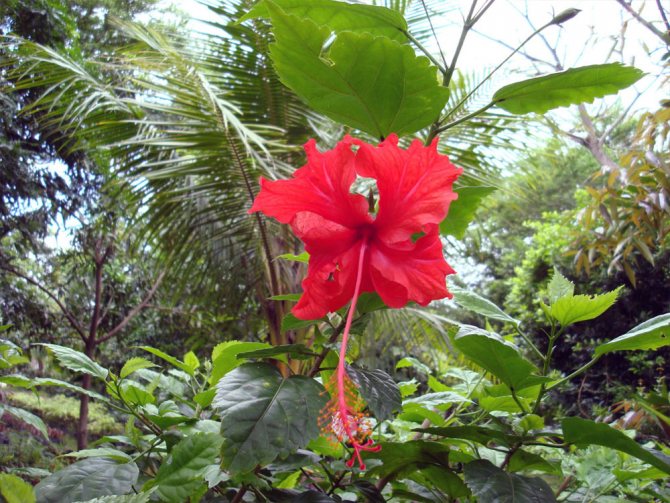

Why doesn't it bloom?
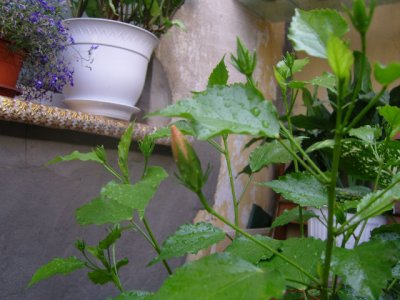

Many growers complain that hibiscus does not bloom at home, has been standing for years and does not want to bloom. Or sometimes a couple of buds appear and fall off without opening.
How to make a Chinese rose bloom?
The guarantee of the flowering of any houseplant is to take proper care of it.
The content of hibiscus also has its own secrets:
- The plant loves sunlight, so it should be kept in the brightest room.
These are the basic rules for keeping hibiscus. But often, even with their observance, there were no flowers and there are no flowers. This phenomenon happens due to the fact that the 2 Key Requirements for Rose Flower Blossom:
- The rose tree must be sent to rest in the cold season;
- Pruning branches.
Practice shows that keeping hibiscus does not require any extra efforts from the grower. The key to health, attractiveness and lush flowering of a plant is proper care and provision of optimal conditions for wintering.
See more photos of hibiscus below:


Reasons for the absence of flowers
Any imbalance can be the reason for the termination of the flowering of hibiscus:
- direct sunlight or lack of light;
- waterlogging of the soil or too little watering;
- nutrient-poor soil or excess fertilizer;
- cramped pot or too roomy tub;
- a sharp decrease in temperature or a sweltering summer heat.
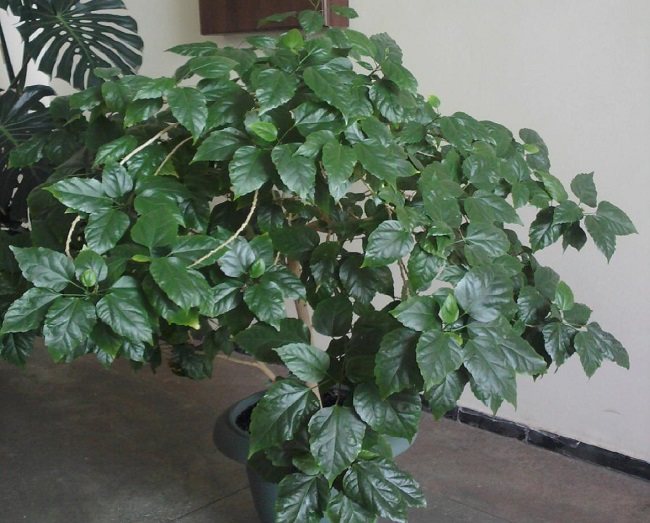

First of all, it is necessary to determine the optimal conditions for hibiscus flowering, to ensure them as much as possible.If you want to wait for terry roses as soon as possible, and you are very upset that hibiscus does not bloom, analyze your mistakes in care and hurry to correct them.
Useful video
Learn more about the flowering of the Chinese rose in the following video:
If you find an error, please select a piece of text and press Ctrl + Enter.
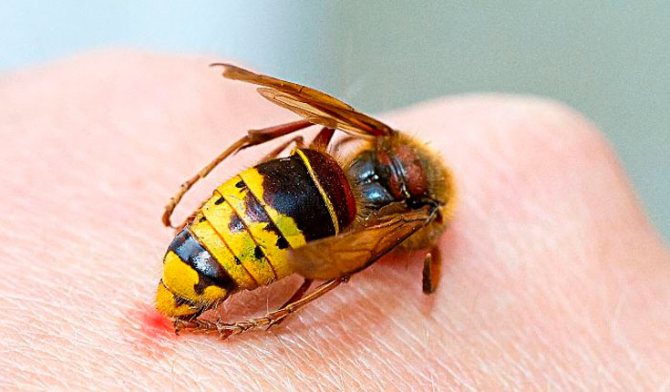

Hibiscus is a tall ornamental plant native to Southeast Asia. This flower is often used to decorate the halls of hotels, restaurants and even hospitals. It would seem that with minimal care, the plant pleases the eye with abundant flowering, while at home hibiscus does not bloom at all. Let's see why indoor hibiscus does not bloom.
Description
The Chinese rose, or hibiscus, refers to the evergreen or deciduous plants of the Malvov family. Natural habitat - tropical forests of the Asian continent.
Hibiscus can be in the form of a bush or tree. It has delicate dark green leaves, carved along the edges, slightly resembling birch leaves.
Hibiscus blooms with large, bright flowers located at the tops of the shoots. Flowers have a wide variety of colors, there is only black, perhaps. In homes, the most common Chinese rose with bright red, lush buds.
In some species, the flower cup reaches 30 centimeters in diameter. The Chinese rose can live a long life, its life cycle is almost 20 years. It is very common to find a bush of this plant as a decoration in homes and offices.


If you follow the conditions of care, then the bush will delight with lush flowering all year round. The most important thing is a sufficient amount of heat and light. And also - water on time and do not forget about pruning the bush. In a city apartment, it is not always possible to comply with the conditions for keeping a Chinese rose, therefore, most often hibiscus blooms at home in the summer for two to three months. But sometimes flowering does not occur at all.
Description of indoor hibiscus
The Chinese rose is a flowering evergreen indoor hibiscus with a smooth, upright trunk and a voluminous crown. The branches of the bush are covered with gray-green bark. In its natural habitat, the height of hibiscus can reach 3 m. The shoots of the bush are completely covered with rather large leaves up to 15 cm long, in the form of an elongated oval with a sharp end.
The edges of the glossy sheet plates are serrated. Hibiscus leaves are predominantly colored deep green, but variegated varieties can also be found. During flowering, bright large funnel-shaped flowers appear on long pedicels, consisting of 5 smooth or double petals. The size of each flower can be up to 16 cm. There are varieties with pink, orange, yellow and red buds.
Chinese hibiscus has become the parent of many hybrid varieties that differ in color of leaf plates and flowers. The most popular hybrid varieties of the Chinese rose include:
- Gait. The flower is distinguished by its lush double pink or orange buds.


Gait - Dark night. The variety amazes with its unique color. The petals of its flowers are painted in burgundy or gray-purple shades. The base of the petals is red.


Dark night - Borias. Shrub with large buds of white or lemon color. The base of the petals is burgundy.


Borias - Parple Majestic. A variety with a variegated color of buds. The wavy edges of the purple petals are adorned with white streaks and blotches that enhance the beauty of the flower.


Parple Majestic - Carmen Keane. One of the brightest varieties of hibiscus, distinguished by an unusual color of flowers. The bright pink petals end in a white, ruffled edging.
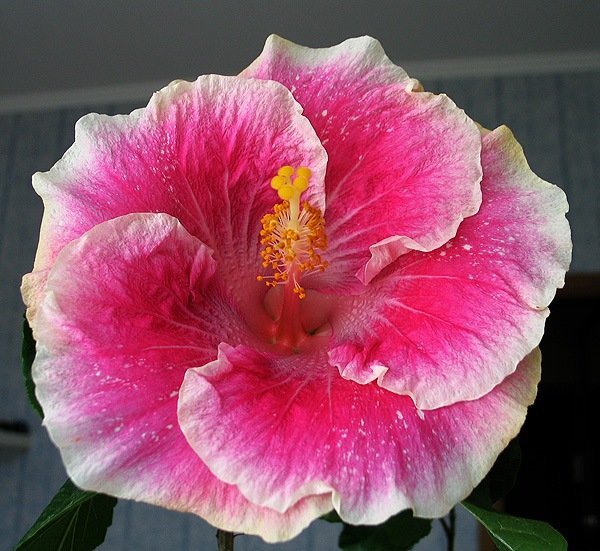

Carmen Keane
All hybrid varieties are as easy to care for as their parent.
Hibiscus or Chinese rose does not bloom.What to do?
To achieve flowering, you need to find a middle ground between proper care and the cramped living conditions of a houseplant.
If you take proper care of the Chinese rose, she will surely thank you with lush flowering. There are often cases when you groom your plant, trying to create ideal conditions for its growth and development, but it only releases a large number of new shoots, increases the leaf mass, but still does not bloom. At the same time, in the hospital next to the house there is an abandoned hibiscus in a dark corner and with all the visible minuses of care - it blooms! What kind of injustice?
Important! The flowering of any plant is a process in which a program is laid for the continuation of a kind, through the maturation and germination of seeds, which means that in order to achieve flowering, you need to find a middle ground between proper care and the cramped living conditions of a houseplant.
Secrets of Proper Care of the Chinese Rose (Hibiscus)
Secrets of Hibiscus Care.
- Hibiscus does not tolerate direct sunlight and heat. Therefore, it is necessary to shade the plant during the sun period.
- You can call the Chinese rose a shade-tolerant plant, however, in this case, other things being equal, it most likely will not bloom. For flowering, she needs a bright room.
- Watering the Chinese rose is necessary often, not allowing the earthy coma to dry out completely. Drought can cause hibiscus to shed leaves and buds.
Watering the Chinese rose is necessary often, not allowing the earthy coma to dry out completely.
Hibiscus responds very gratefully to daily spraying. In the spring and summer, at high temperatures, spraying is advisable to do twice a day. Hibiscus responds very gratefully to daily spraying.
Important! Spraying should be carried out in the morning or in the evening, so that excess moisture on the leaves does not lead to severe burns of your plant.
In the spring-summer period, you can (even need to) take Hibiscus out into the fresh air - a balcony or loggia.
Reasons for dropping buds and leaves
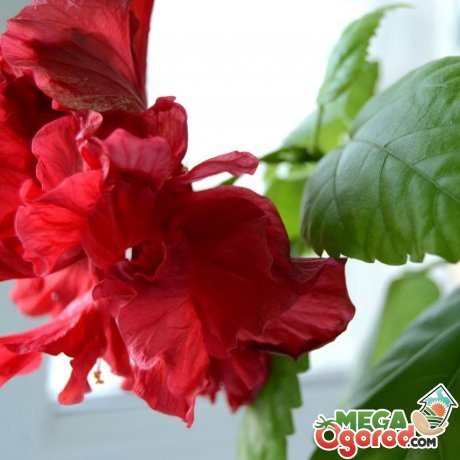

It may seem that the Chinese rose is a low maintenance plant. But in fact, this is a rather capricious flower. If the usual conditions are violated, the Chinese rose reacts by dropping flowers, buds and even leaves:
- The flower reacts especially violently to a sharp change in temperature. If a Chinese rose, which was in the garden in the summer, is brought into the house after a strong drop in temperature, it will shed all its leaves in a couple of days. But do not throw the bare trunk out of the pot. The branches are pruned and the plant is sent to rest. Watering so that the clod of earth does not dry out. Then, closer to spring, they increase watering and raise the temperature.
- The flower also throws off its leaves when it stands in a draft.
- In summer, the Chinese rose sheds its leaves if it is watered too abundantly. In this case, the amount of moisture is reduced to dry the soil.
- The Chinese rose does not like changing illumination. If the plant pot is turned frequently, it can shed the buds.
- If the air in the room is too dry, the buds fall off. It is necessary to spray the leaves every day with a spray bottle.
- The Chinese rose can shed its leaves and buds if too much fertilizer has been used to care for it. It is necessary to reduce the dose of fertilizers or stop applying them altogether.
With insufficient fertilization, plants may look thin and naked. Fertilizers in this case are administered once a week. But the concentration is reduced by 2 times.
How to make hibiscus bloom at home?
To make a hibiscus bloom, you must first determine the reason why it does not bloom, and only by solving the problem, you can achieve its flowering.
Reasons why hibiscus does not want to bloom and how to solve them
- The most common reason hibiscus does not bloom is the lack of a dormant period.Even if you cut back on watering and did not feed your plant, then, alas, this is not enough for the flowering of the Chinese rose. Remember that abandoned Hibiscus in the neighboring hospital, which blooms profusely? The secret is simple: the buds are laid precisely during the dormant period, and this requires a fairly low temperature - about 15 °.Now everything becomes clear. At a time when the heating was not turned on yet, you were so worried about your plant that you tried to provide it with a more comfortable and warmer temperature, while the temperature in the hospital lobby was low. And what do we have in the end? The hospital plant blooms, but the home plant refuses.How to solve the problem?Unfortunately, most likely it will not be possible to solve this problem in the current season, and with the onset of cold weather, you need to behave correctly, and then you will get a beautiful flowering plant in summer. But, you can try to feed Hibiscus with potassium-phosphorus fertilizer, or buy a special fertilizer for budding... Not a fact that will help, but trying is not torture, is it?
Hibiscus buds are laid precisely during the dormant period, and this requires a fairly low temperature - about 15 °.
Another problem that makes hibiscus flowering impossible is lack of spring pruning... Do not be afraid to prune the Chinese rose, it is very beneficial for her and for you. You have the opportunity to form a beautiful crown, and in Hibiscus, buds are laid only on new shoots... With every uncut branch, you lose a bud. If the reason was this, then after pruning, the Chinese rose should bloom in just a month.
Another problem that makes hibiscus flowering impossible is the lack of spring pruning.
Another reason hibiscus does not bloom is that the pot is too spacious.
How to create optimal flowering conditions
An important point in grooming measures for a Chinese rose is to create conditions for the formation of buds. This moment occurs during the dormant period, before the beginning of the active growing season. Preparation should be done with the arrival of the autumn cold.
To do this, the bush is moved to a room with a temperature not higher than +15 and not too bright lighting, the sun should not penetrate the leaves. Therefore, it is worth choosing the most secluded place. Watering at this time is needed more than moderate. You just need to ensure that the earth does not dry out at all.
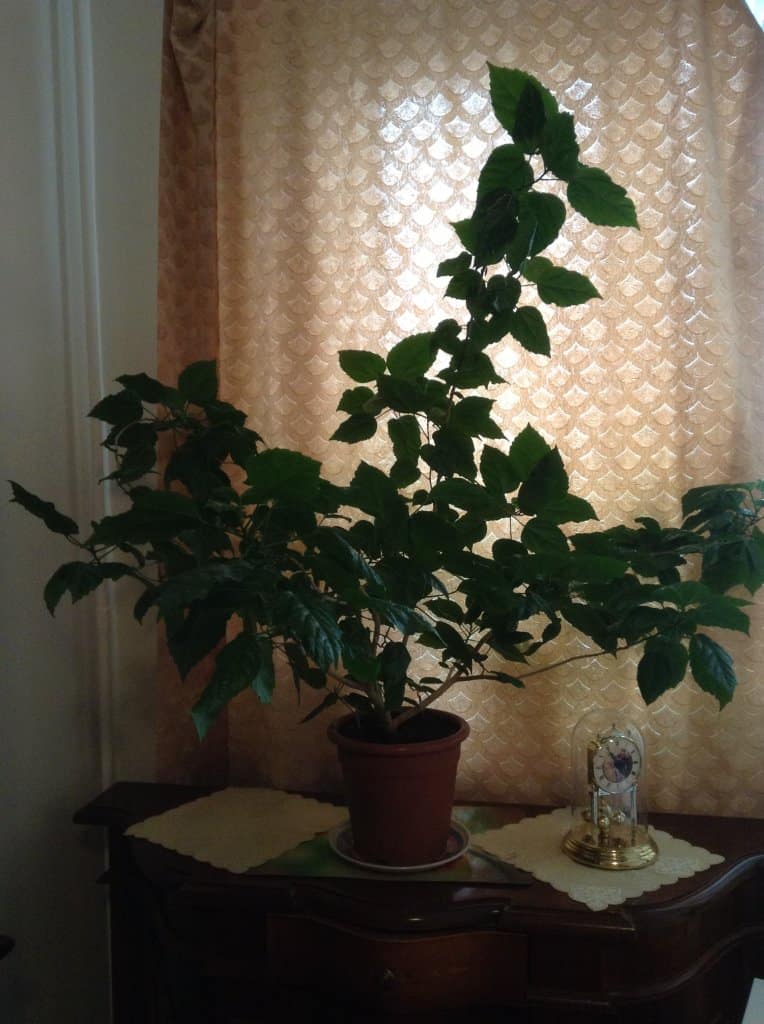

By the beginning of March, new leaves begin to appear. This suggests that the bush has woken up and is preparing to bloom.The rose pot is moved to a permanent place with good lighting.
This moment must be closely monitored. If you do not release the flower from the darkness in time, then the buds may crumble, and others will not appear.
During the active growing season, regular watering of the bush must be observed. Do not allow the topsoil to dry out. Usually, watering is carried out every other day, using only warm water, which has been settled for at least one day. They also carry out daily spraying of the bush, since dry air can even lead to shedding of leaves.
On warm summer days, the rose feels great on the balcony or in the garden, but only if there are no drafts and strong winds.
Selection of soil and fertilizers
The soil mixture for hibiscus should be selected loose, with high air permeability. Loosening the soil in the pot is carried out every week to give oxygen access to the root system. The best composition of the substrate for hibiscus will be the presence of turf, humus and leafy soil in equal proportions.
The abundant flowering of a rose is possible only in a nutrient-rich substrate. From March to September, every week, complex mineral supplements, in which phosphates predominate, are regularly introduced. When buying fertilizer for a Chinese rose, you need to pay attention to the composition. The predominance of nitrogen components will lead to an intensive build-up of green mass, and flower ovaries may not form.


The increased phosphate content in mineral dressings promotes lush flowering and abundant bud setting. But at the same time, you need to know that an excess of a substance will harm the plant.
For the growth of green mass, spraying on the leaves with a solution containing nitrogen is good, avoiding contact with the flowers (whitish spots appear on them from the solution).
Do I need to transplant
Transplanting a bush is a prerequisite for lush flowering. The best time to transplant is the beginning of the growing season. When transplanting, you must follow some rules:
- you cannot choose a container that is too large for a flower, ideally - five centimeters narrower than the diameter of the hibiscus crown;
- when transplanting, the root system is shortened by a third, which contributes to the formation of ovaries;
- the soil in the pot should be loose; for this, sand is added to it.
For young bushes, the transplant should be annual, and for older ones, over five years old, once every 3-5 years.


The need for pruning
A prerequisite for the emergence of buds on hibiscus is pruning the stems. You need to know that flowers are formed only on young shoots that grow after pruning. If this event is neglected, then there is practically no chance to see the flowering of the Chinese rose.
For the same reason, pruning cannot be done during the active growing season. Having destroyed the emerging buds, one cannot count on flowering.
By pruning old shoots in spring, they enable the growth of young branches, because the buds are formed on them. When pruning, old branches are removed along with foliage, leaving only a bare branch. Young shoots will soon begin to form from it.
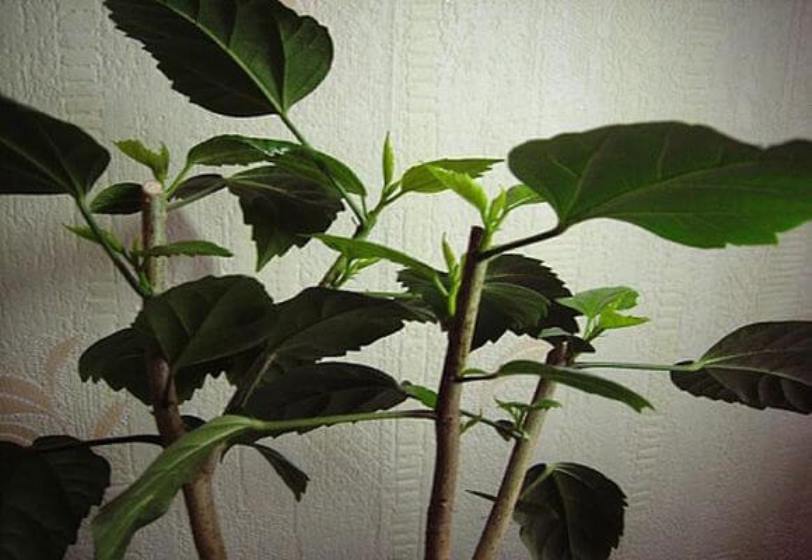

The procedure is carried out every year, during the dormant period, before the active growth of the flower begins. In this case, you can give the crown a very different shape, forming it to your liking during pruning.
https://youtu.be/lhO8ARPaDdU
Insect pests
A rose will not be able to bloom if it is attacked by parasites that suck the juice and deprive it of vitality. Insect pests can lurk in the soil brought in for replanting.


Infection can occur from a diseased plant in the immediate vicinity:
- Aphids devour delicate leaves and buds. Its presence is indicated by a sticky coating on the stems and buds.
- The presence of a spider mite living on the inner side of leaves is manifested by the presence of a thin film-cobweb.
- The sticky mass on the leaves is the traces of the whitefly's vital activity.
- Wax strips-secretions on the leaf plates remain from the activity of the worms.
- Brown bumps on the branches are the work of the shield.
- Damaged buds eaten away inside are traces of gall midge.
To combat parasites at the initial stage, a solution of soap in water, which is used to treat the affected plant, helps. You can get rid of the scale insect with the help of insecticides, and the mineral oil will remove the scale insects from the bush. A good effect is given by replacing the soil with further treatment with a fungicide.
Diseases
Improper care leads to the occurrence of any disease. If you bring it back to normal, then the rose will quickly recover. Fundamental rules:
- watering should be regular, but not excessive;
- the plant should be in a well-lit room, but slightly shaded;
- be sure to feed during the budding period - every week, then - once every 30 days;
- during the dormant period - reduce watering to a minimum, ensure that the temperature for the plant drops to +15 degrees (lower temperatures can lead to the leaves falling off);
- the presence of good drainage in the pot.
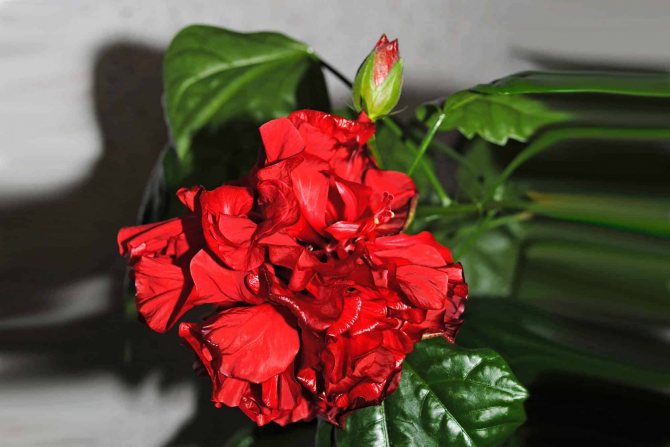

Why hibiscus with yellow leaves does not bloom
It should be noted that only healthy hibiscus flowers bloom, which have the necessary conditions for development. If spots appear on the leaves of any format or the leaf blade turns yellow, these are signs of a disease. So, green drooping leaves will say that the plant is dry, then it will lose color and buds.
Yellow leaves can give a signal that there is a disorder with the root system, and there is no need to wait for flowering under these conditions. In addition, insect pests can colonize the plant, taking food from the hibiscus. Therefore, each pruning, watering, wiping the leaves should be combined with a preventive inspection of the plant.
Compliance with agricultural technology will allow you to annually enjoy the victorious flowering of a tropical plant, which brings harmony to the house in the relationship between family members.
Hibiscus care experience - video
Transfer
The signal to transplant a plant is to peek out the roots through the lower drainage holes of the pot. Hibiscus grows very quickly. Only a new capacity slightly larger than the previous one can restrain its growth. An overly large pot is destructive. They are transplanted into the purchased ready-made soil, consisting of a sheet array. Peat is too heavy for a Chinese rose. If a pot of a suitable size is not available, then a higher drainage layer must be used. For this, pebbles or expanded clay are suitable. When a container of suitable size is selected, a layer of 2 cm pebbles is enough. A light soil 2-4 cm is poured over the drainage.From the first to the fifth year of life, the Chinese rose is transplanted annually. A five-year-old or older plant is transplanted every 2-3 years. But every year, fresh soil is poured in a layer of 3-5 cm.
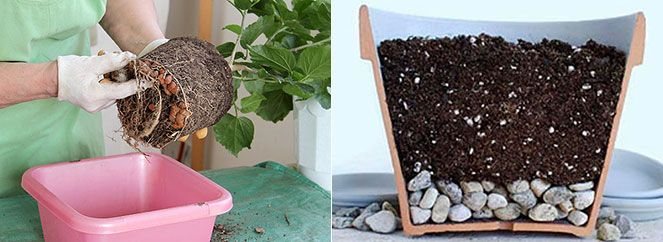

When transplanting, they are guided by the difference between the diameter of the previous and the next pot of 2-2.5 cm. If the rule is violated, the plant will fatten and grow only green mass. Full flowering this season is achieved only by increasing the drainage layer.
When transplanting, the hibiscus is removed from the old pot, carefully laying it on its side. Tap on the sides of the container to make it easier to remove the plant. The roots are examined for decay, podoprevanie or pests. With the help of a pencil, the roots are freed from the excess layer of old soil. It is important not to be zealous so as not to tear off the living parts. White blotches between the roots are not a disease, but perlite, it is added to increase the air permeability of the soil.
The flower is placed strictly in the center of the new container. Sprinkle the soil, slightly compact it. Before burying the roots, take into account that the sides of the pots should protrude 1.5-2 cm above the soil layer. Such a reserve will simplify subsequent watering. The pot is watered for the first time a day after the transshipment.So that the plant does not suffer much and takes root faster, it is better to shed it well 3-5 hours before transplanting.
Plant shaping
Homemade Chinese roses are pruned in the spring, fall, or after transplanting. But sanitary removal of dying branches is carried out at any time of the year. The plant is formed with scissors, pruning shears or a knife. The instrument must be sharp and disinfected. For this, rubbing alcohol is suitable. Wipe all cutting edges with a cotton pad moistened with medical alcohol. The treatment is repeated after each cut so as not to infect healthy branches. In addition to tools, they store activated or charcoal. It will be needed to sprinkle the cut sites for better and faster healing. In one procedure, no more than 2/3 of all shoots are removed. The most powerful pruning is done when it is affected by diseases or pests. In diseased plants, it also happens that all shoots are removed, leaving only a small stump.


Sanitary pruning
Sanitary pruning removes any dried stems or those that grow inward towards the main stem. Each cut is made at a 45 degree angle. The branch on which the bud has bloomed should be shortened by 2-3 cm, this will have a beneficial effect on the future flowering period. Tops must be removed from the main stem - short branches along the trunk, on which peduncles do not form. Such shoots only thicken the plants, draw off nutrients and impair ventilation inside the crown.
Stamp trimming
Standard hibiscus is formed on a young plant. A support is tied to the main straight stem and new lower lateral shoots are constantly cut off, until the trunk becomes lignified. As it grows, the trunk is constantly tied up at regular intervals. When the rose has reached a given height, pinch the upper central shoot. This leads to stimulation of lateral stem growth. Abundant branching of dormant buds and monthly pruning of lateral shoots will give the flower a lush spherical crown.


The process of forming a standard Chinese rose
The spherical shape is maintained constantly throughout the year. They remove internal thickening shoots and lower ones that spoil the appearance. The most radical pruning is delayed until the fall months, when the hibiscus has faded and prepares for a dormant period.
Bonsai
Only experienced flower growers can form a bonsai-style plant, or strictly following the rules:
- The greatest difficulty is the rapid lignification of the branches and trunk of the hibiscus.
- The direction of the trunk of the hibiscus tree is set using a flexible but solid support and wire.
- Change the angle of inclination every 2-3 months.
- To make a flowering bonsai, you have to be patient. Until the trunk takes the given shape, the plant is not allowed to bloom, removing all the buds.
- The branches of hibiscus-bonsai are shortened when they reach a length of 10-20 cm. They are cut off, leaving 2-3 leaves.
- In an adult bonsai plant, after flowering, the shoots must be cut off so as not to disturb the given shape.
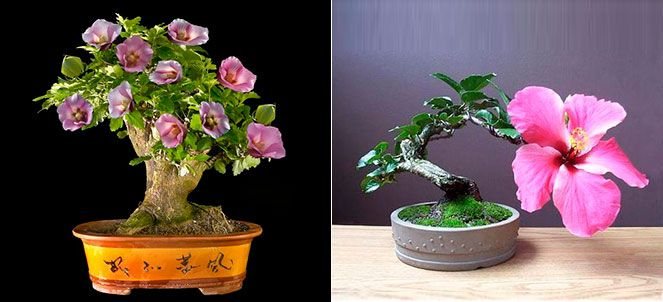

The Chinese rose is resistant to pruning and shaping, so it does not need special care after the procedure. The rules for watering and feeding remain the same.
Reproduction
The Chinese rose is propagated in two ways: by cuttings and growing from seeds. Seed propagation in hibiscus, unlike many other potted crops, is very productive. But grafting is more efficient and faster.
Cuttings
After pruning, branches remain that can be used for propagation. For this purpose, cuttings 8-10 cm long are suitable. The lower large leaves are removed, exposing part of the trunk, treated with any stimulant for the growth of the root system, for example, Kornevin. Then placed in sandy soil or a container of water. Full roots appear in 3-4 weeks. Then the plant can be transplanted into a separate pot.


The apical parts, pinched from an adult Chinese rose, are also suitable for cuttings.The rooting procedure is the same as for other shoots, the main thing is that 2-3 internodes remain on the shoot. The plant will give abundant flowering after 3-4 months.
Seeds
Hibiscus seeds remain viable for 5-6 years. Before planting, the planting material is awakened by treatment with a growth-stimulating solution. Swollen seeds are immersed in a light substrate. Cover with polyethylene and create a mini greenhouse. It is ventilated daily. The sprouts will appear in 10-12 days. In the three-leaf phase, the hibiscus is dived and planted in miniature pots.
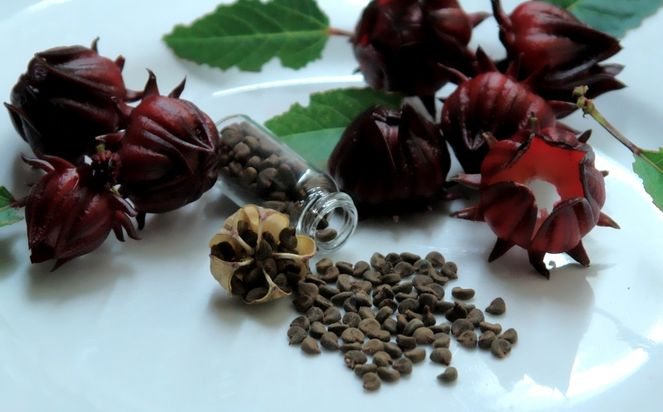

A Chinese rose grown from seed will bloom for 3-4 years. And propagated by a cuttings - in the same or next year.
Planting and breeding
To grow hibiscus, you need a loose and very nutritious soil mixture, consisting of about 2 parts of turf, 1 part of leaf and 1 part of humus soil, you can add a little peat and sand. At the bottom of the pot, drainage must be laid.
Young plants grow very quickly, so they may need to transplant into a larger pot more than once throughout the year. In the future, every year in early spring, they need to be transplanted into fresh fertile soil. Adult plants are rarely transplanted, but every spring they replace the top layer of potted soil with fresh, more nutritious ones.
At the end of winter, it is useful to prune an adult plant, this stimulates abundant branching and flowering. The branches are cut two-thirds or half. The resulting cuttings serve as propagation material. They quickly release roots in water or when placed in a greenhouse in a loose substrate. For reproduction, you can cut off the tops of young shoots not only in spring, but also in summer, preferably in August. Young plants, with good care, bloom after a few months.
conclusions
What you absolutely should not do if you want to wait for the flowering of the Chinese rose:
Blooming hibiscus is an undeniable decoration for any interior. Its bright and lush flowers are a real reward for gardeners who can truly take care of it by providing the right care.
Conditions of detention
Chinese hibiscus is quite unpretentious and shade-tolerant, but it is preferable to keep it in bright enough roomavoiding direct sunlight. This is one of the conditions for good flowering. In summer, it is useful to expose the plant to fresh air in a bright place protected from the wind. The optimum temperature of the content is in the range of 18-22 ° C.
The flowering period of Chinese hibiscus usually occurs in spring, summer and autumn: its crown is periodically decorated with magnificent single double flowers. Watering at this time should be regular and abundant after the topsoil has dried. After watering, the soil must be loosened to provide air access to the roots. Strong overdrying of the soil during this period is unacceptable., otherwise the plant will drop foliage and buds. In winter, watering is reduced. Hibiscus is very responsive to fertilization, in the spring-summer period, an adult plant is fed about 3 times a month with mineral fertilizers or a weak organic solution. In winter, they are fed with a weak solution of fertilizers once a month.
Useful daily spraying, especially in winter when kept in a warm, heated room with dry air.
And now - attention! Very often there are complaints from flower growers that, they say, I cherish my rose tree - I hold it in the sun, and I water it regularly, and I feed it, but it does not bloom - at least burst it! And if you look in some store or institution, there is a tree forgotten by everyone in a tub in a dim hallway, no one takes care of it, they water it as needed, but it blooms without ceasing. A familiar picture, right?
And the thing is that the laying of flower buds in the Chinese rose tree is facilitated by an air temperature of about 15 ° C... At this temperature, the soil dries out slowly, therefore, it should be watered very rarely. And this - the main secret of getting luxurious flowers... As a rule, such conditions in the above-mentioned state institutions develop in the fall, when the heating season has not yet begun, and the cooling is already noticeable. At this time, the room is very cool and the hibiscus falls into a dormant state, actively laying the rudiments of flower buds, which are activated with the arrival of spring. Please note that similar conditions develop in apartments with central heating in the fall, and you just need to use them so as not to interfere with the plant's proper rest. And with the heating turned on, you just need to place your hibiscus in the coolest place of the apartment (even in a dimly lit one) and not disturb you with unnecessary watering until the end of winter.
Awakening occurs around February, this can be seen from the beginning of the growth of young leaves. Then the plant is rearranged in a bright, warm place and little by little they begin to water and feed. If the moment of awakening is missed and you will rearrange the hibiscus already with buds, then be prepared for the fact that with a sharp change in the microclimate, it can drop the first buds and even partially the foliage. Then, of course, he will catch up, but it is better not to arrange such an extreme for him.
Hibiscus diseases
The main reasons leading to diseases of the domestic Chinese rose:
- insufficient moisture, leading to shedding of foliage;
- neglect of sprinkling and spraying;
- draft;
- direct sunlight, leading to burns;
- dustiness of leaves, impairing the process of photosynthesis;
- excessive watering leading to root rot;
- watering with cold, not settled water;
- untimely transplantation, from which the plant withers;
- using blunt or non-decontaminated tools when pruning;
- a large or small number of dressings;
- bad light.
Insect pests
Hibiscus is infected by contact with a diseased plant or when transplanted into contaminated soil. The most dangerous for the domestic Chinese rose:
- Aphids, nestles in flowers and young growth.
- Spider mite, lives on the back of leaves. The best breeding environment is warm, dry air.
- Whitefly, settles at the bottom of the leaf. Its larvae cover the plant with a sticky mass, leading to yellowness.
- Worms, habitat - leaf sinuses.
- Scutes, showing brown tubercles on the stem.
- Gall midge, its larvae eat buds and young leaves.


Hibiscus leaf covered with whitefly larvae
To combat, they use specialized chemical agents, folk methods, improve daily care, cut off diseased parts or transplant a plant. Actions are carried out one at a time or in combination, depending on the degree of damage and the effectiveness of previously used agents.
Why doesn't bloom come?
There are several reasons why flowering does not occur:
- Improper care. The plant itself is not whimsical, but problems can arise with improper care. What not to do:
- keep the flower in a hot and dry room;
- do not spray regularly, especially in summer;
- place the pot in a draft or in direct sunlight;
- watering often, this leads to rotting of the flower;
- water with unsettled water, it may contain harmful impurities;
- not transplant and fertilize on time;
- turn the flower upside down to the sun.
- Diseases. All diseases are associated with improper care. Observing the peculiarities of care, hibiscus will quickly recover. Prerequisites to get the plant back to normal:
- regular watering without drying out or overflowing the soil;
- finding a rose in partial shade;
- fertilizing with fertilizers during flowering - once a week, then - once a month;
- in the autumn and winter periods, the air temperature should be + 15C, watering should be minimal;
- spray the flower every day;
- good drainage in the ground.
- Pests. Parasites can appear during transplanting if the soil has been contaminated. Also on contact with diseased plants:
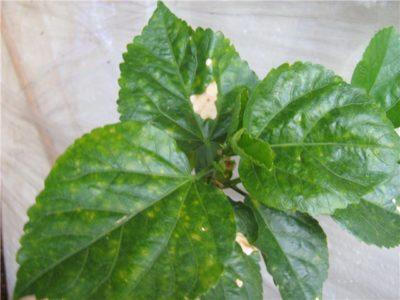

aphids destroy young leaves and unopened buds, covering them with a sticky layer; - the spider mite lives under the leaves and envelops them with a thin film;
- the whitefly covers the leaves with a sticky liquid, which makes them turn yellow;
- worms leave a waxy discharge on the leaves;
- with the appearance of scale insects, tubercles appear on the stems of brown color;
- the gall midge eats the buds from the inside.
How to deal with parasites:
- soap solution will help get rid of aphids;
- insecticides are good for scale insects;
- mineral oil removes worms;
- potash soap destroys the whitefly;
- treatment with soapy water saves from spider mites.


